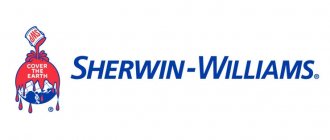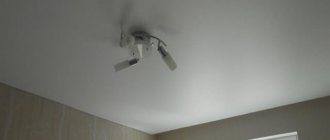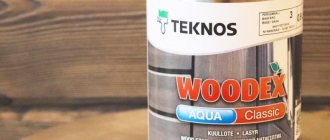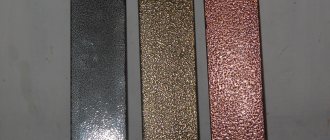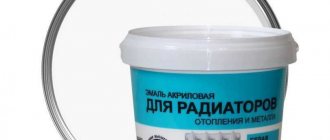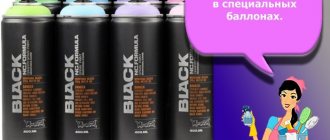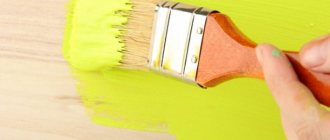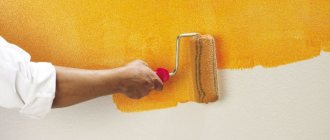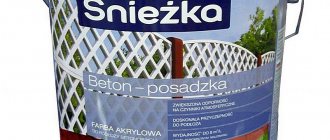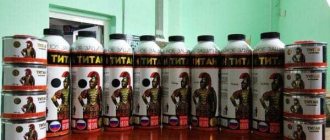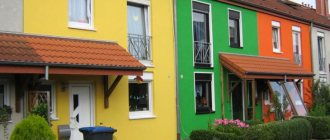Since the advent of universal latex, silicone and acrylic compositions with better characteristics, the popularity of oil paints has fallen sharply, but they continue to be used due to their relatively low cost and unique performance properties. Oil-based paint coatings can reduce repair costs, so the demand for them will never disappear.
How to choose oil paint
Oil-based paints are moisture-resistant and hygienic. They are easy to apply to the surface, they can be used to cover interior and exterior elements, and after drying they give the materials an aesthetic appearance. After complete drying, a film is formed that reliably protects surfaces from the negative effects of weather conditions, including direct sunlight and high humidity.
However, in addition to positive properties, there are also disadvantages, including a short service life (up to 3 years), flammability, toxicity coupled with a pungent odor. In addition, the coating fades quite quickly in the sun. Below are the characteristics to consider when choosing.
Purpose
Manufacturers of oil paints clearly indicate which surfaces they are suitable for. In addition, the location of staining is also important. For example, options for exterior finishing are more toxic and their use indoors is not recommended. At the same time, they have better protective properties and are more resistant to aggressive environmental influences. The majority of the market offers universal oil compositions that are equally suitable for use outside and indoors and retain their properties when applied to both metal and wooden surfaces.
Consumption
This parameter depends on the absorbency of the surface being treated coupled with the viscosity of the coloring composition itself. As a rule, the consumption is about 150 grams per square meter. For example, wood will require more paint than the same area of concrete.
Drying time
One layer dries completely within 24 hours, but some manufacturers produce formulations that require only 12 hours to dry.
Viscosity level
The fluidity, drying time, uniformity of the applied layer and the complexity of its distribution depend on this parameter. The optimal viscosity level is between 65 and 140 units. If the value differs from the figures given, this is direct evidence of the low quality of the composition.
Degree of grinding of pigments
The parameter determines the size of the largest particles in the coloring composition. The higher the degree of grinding, the greater the hiding power of the paint and the better the treated surface looks. For oil paints there are two levels of grinding:
- below 90 microns – fine-grained;
- above 90 microns – smooth.
Volatile content
A characteristic feature of oil paint is its pungent odor due to the release of harmful volatile substances. In a high-quality composition, their share does not exceed 10%. This indicator should be taken into account if you plan to paint interior elements in a poorly ventilated area. It should be remembered that as the ambient temperature increases, harmful substances are released much more actively.
Proportion of film-forming substances
In the total volume, the amount of these substances should not be lower than 26%. As this level decreases, the density of the paint coating and its hiding power deteriorate. With a significant increase in the proportion, the storage time of the paint is reduced.
Degree of water resistance and film hardness
Standard indicators of film water resistance are in the range of 0-0.5 units, hardness - 0.13 units. A decrease in the last parameter indicates low quality of the coloring composition.
Materials for painting. Oil paints. Manufacturers of oil paints.
In the range of products for artists, the “oil paints” group occupies a special place - it is a strategic product that supports daily income. In the form of loose (individual tubes) it is comparable to stationery pens or notebooks. This is why the topic of oil paints is so interesting to market professionals.
PRODUCTION OF OIL PAINTS ... The production of oil paints begins with weighing the components and then mixing them in large containers called bowls. Each plant's paint recipe is unique; as a rule, it is developed over years and is not subject to publicity. In separate workshops, a binder is made, which is then supplied together with pigments for grinding. The composition of the binder for oil paints includes oil, wax, natural resins (dammara, mastic), which have a positive effect on the optical properties of paints - increasing the brightness and purity of color after drying. To give paints better consistency and other properties, united under the general term “pastiness,” natural thickeners are introduced into them. All these components are fused with heated oil to obtain a homogeneous mass - a binder. This substance got its name because it is designed to “bind” pigment particles, turning everything into a single whole - paint. When paint is applied to the canvas, the binder evaporates, forming a film on the surface that holds particles of colored pigment, preventing it from “falling off” from the surface. The role of the binder in oil paints is very important, so its production requires great skill. As a rule, only large plants with high-precision and high-performance equipment can make high-quality binders. The heart of any paint production plant is the chemical laboratory. Within its walls, raw materials, semi-finished and finished products are controlled. Professional chemists invent new types of paints, improve old ones, and expand the color palette of produced paints. Samples of artistic paints from each batch are brought to the laboratory, where they are checked for indicators of pastiness, ductility, adhesion, grinding, viscosity - to ensure that all these indicators comply with standards. After testing, the laboratory gives a conclusion. If the paint is ready, it is sent for packaging; if not, it is sent for revision. Grinding of paints is carried out in special paint grinding machines, the main working parts of which are granite or iron shafts and grinding knives. The grinding of paint is carried out due to different speeds of rotation of the shafts - the lower shaft rotates slower, the middle one three times faster, the upper one three times faster. Thus, the paint is captured onto the shafts. It is removed from them with knives and flows back into the tank. This process is very long, repeated many times - sometimes it takes several days, reaching 30-40 grindings (for different paints the number of grindings is different, it is selected individually, based on the characteristics of each paint). The grinding index of a paint is called the degree of dispersion of the pigment in the binder. The paint is ground until this indicator (that is, the particle size in the finished paint) reaches a certain value. During the grinding process, paint samples are constantly delivered to the laboratory to determine the degree of dispersion. The color of any paint is determined by the pigment included in its composition. Pigments can be divided into organic and inorganic. Organic pigments are brighter, while inorganic pigments produce natural shades, subtle transitions and highlights. When developing formulations, the optimal ratio of pigments and fillers, as well as binder components, is selected, which allows for purity and depth of color, and high physical and chemical properties of the paint. How well the binder and pigment are combined (the quality of the grind) is checked using a grindometer. Indicators that determine pastiness, consistency and ductility are also checked. In order for the artist to work comfortably, the paint should not be too thick and too heavy and at the same time, it should not be too “weak” to maintain the shape of the stroke on the picture. To test the lightfastness, paint is applied to the canvas and placed on display. From May to September, paint samples are placed where there is access to the sun and then compared with samples that have not been tested by the sun. In the same way, white is tested for its ability to remain white for a long time and not turn yellow. For packaging oil paints, tubes made of soft imported aluminum with a latex coating in the shank are used, providing additional tightness. After pigments, oil is the most important component of paint. The characteristics of the finished paint will directly depend on its quality and the quality of its processing. Of the many varieties of oils, linseed, due to its amazing properties, is considered the most suitable for the production of oil paints. In art paints, imported oil is used, not because we do not know how to make this oil, but because the flax growing on our territory does not have the characteristics necessary for art paint. Flaxseed oil undergoes heat treatment to improve the properties of the paint - increasing its viscosity, weather resistance, and durability.
OIL PAINTS ON THE COUNTER Alla Nikolaevna Novikova (“Art-Mosaic”) helped us understand the types of paints, their properties and features that we need to know for successful sales: “for the production of highly artistic paints, poppy, safflower, nut oils or specially processed linseed oils are used . The advantage of these oils is that they do not turn yellow over time, thus providing high light fastness to the paint. For simpler paints, so-called studio paints, refined and polymerized linseed oils are used. High-quality paints are rubbed on both earthen and cadmium-cobalt group pigments. These are quite expensive pigments with very high light fastness and purity of tone. In studio paints, along with earth pigments, pigments that imitate cadmium and cobalt are used. Advances in modern chemistry have made it possible to obtain a wide range of pigments that are not inferior in quality to natural ones, have good light fastness and purity. Over the centuries, three main groups of paints have emerged: highly artistic, studio and sketch. Highly artistic paints are materials for the most demanding craftsmen. They are made using high-quality oils and pigments, including natural cadmium and cobalt pigments, and with the minimum filler necessary to improve the quality of paints. Studio paints are made using high-quality linseed oil, but without the use of cadmium-cobalt pigments, which are replaced with imitation ones. Imitations of cadmium and cobalt pigments are of excellent quality, are as close to natural as possible, and have fairly high light fastness and hiding power. One of the advantages of these paints is their low prices. Sketch paints are materials for performing less critical work. Optimally good for beginning artists. They are mainly made on the basis of inexpensive pigments and with a large percentage of fillers and oils. Before offering paint to your customers, first of all, you need to determine for what level of work it is being purchased. If this is a responsible job, then, despite the high price, you need to buy paints from a highly artistic series. For sketches, sketches, term papers and dissertations, paints from the “studio” series are well suited. For design orders that require a large amount of paint, a sketch series is sufficient. Read the information on the label carefully. First of all, the name of the paint. Pay special attention to the presence of pigment quality characteristics - “imitation, azo or color”. On the paint labels of European manufacturers they are indicated by the words azo or hue. This means that the paint belongs to the “studio” series and is made using imitation pigments of the cobalt-cadmium group. Also carefully read the information about the lightfastness of the paint, which is designated as follows: * - slightly lightfast, ** - moderately lightfast, *** - lightfast. For white, this marking means: * - strongly yellowing, ** - medium yellowing, *** - not yellowing. A special symbol denotes opaque or glaze paint, that is, transparent. On the tubes of European manufacturers you can also often see the inscription “series …” - this indicates the price group. Many manufacturers indicate the composition of the paint on the labels.”
"ART PAINTS PLANT" Since its foundation, the "Art Paints Plant" has been producing oil-based artist paints. Today its range is represented by several series. The Master Class series are high quality paints intended for oil painting. The Master Class series palette includes opaque, translucent and transparent paints. The latter have low hiding power, which allows them to be used especially successfully in the glazing technique. The vast majority of pigments used for the manufacture of paints in this series are obtained at high temperatures by calcination (for example, cadmium, cobalt, iron oxide). In addition, natural earth pigments are widely used. Such pigments are extremely chemically resistant; paints based on them are highly lightfast. Part of the “Master Class” palette consists of paints based on modern pigments of organic origin, which have high light resistance. The names of the paints in the “Master Class” series, with a few exceptions, correspond to the names of the pigments that make up their composition and determine the color. Artistic oil paints of the “Ladoga” series are ideal for those who are learning the art of painting, as well as for those artists who are demanding on quality and sensitive to price. The paints of the “Ladoga” series, having the basic consumer properties of paints for oil painting, differ from the “Master Class” series by the predominant use of cheaper, but no less durable in comparison with inorganic, organic pigments. Using carefully selected ratios of components, paints were created whose colors are similar to those of paints based on more expensive cadmium and cobalt pigments. This made it possible to make Ladoga series paints more accessible to consumers. Such paints are designated on the labels with the letter “A” - analogues. At the same time, the composition of the earth paints in the series (ochre, sienna, umber) includes natural earths. According to consumer demand research conducted by the ZHK marketing department in 2003 in 27 cities of Russia (South, Volga region, Western Siberia, Central region), consumers are well aware of the Master Class and Ladoga brands. The respondents not only chose these brands among the proposed options (among the brands of other paint manufacturers), but also named these brands in open-ended questions (without answer options). Both brands are equally in demand, as evidenced by sales data. The price of oil paints is formed based on an analysis of competitors' prices on the market, taking into account production costs. Since the range of paints is quite wide (66 “Master Class” and 39 “Ladoga” paints), for the convenience of buyers and in accordance with generally accepted practice among oil paint manufacturers, several price groups are distinguished. Within a price group, paints have a single price. The palette of the “Master Class” series includes 66 intense and pure colors. Of these: 53 mono pigment paints; 63 paints with light fastness ratings ** and ***; 8 natural cadmium and 10 natural cobalt paints. The “Ladoga” series contains the most popular colors among consumers (39), 35 of them with light fastness ratings of ** and ***. Each series also includes paint sets in cardboard boxes of 6, 8, 10, 12 colors and gift sets in varnished wooden boxes with 12 18 ml tubes and a glass bottle of linseed oil (or with a brush). Among the rich palette of paints produced by the plant, there are paints of amazing origin and history. Peach Black is made from a pigment obtained by calcining peach pits, and Wolkonskoite is a one-of-a-kind earth green paint. The paint is made on the basis of a unique dark green pigment with a pistachio tint. Unlike other pigments, this one is extracted from a mineral whose deposits are found only in Russia. The mineral itself comes in different shades from dark green to bright green. The paint is valued by artists for its transparency, along with its pure color and unique shade. Among oil paints, there are those whose creation history deserves special attention. For example, the Neapolitan Yellow was originally created by order of the State Hermitage for the restoration of Rembrandt’s painting “Danae”. The golden shower falling at Danae's feet was restored precisely with the help of the Neapolitan yellow "Artistic Paints Factory". The Master Class series includes 5 new colors: Grass green, Olive, Neapolitan yellow-fawn, Neapolitan nude and Neapolitan pink. These paints were developed based on consumer requests to expand the palette of Neapolitan and green paint groups. The paints are made from high-quality pigments, have excellent covering power and high light fastness. The paints favorably complement the paint palette produced by ZHK.
"GAMMA" Oil paints produced by JSC "Gamma" are distinguished by the following properties: - high color purity due to the use of only one and very rarely two pigments in each paint; — a high degree of grinding of paints and their optimal consistency, which allows the paints to spread well over the base and maintain plasticity after drying; - excellent light fastness - preservation of the color and tone of the paint after drying; - all paints have the same consistency, which makes them easier to mix on the palette; — the paints have excellent adhesion. "Gamma" paints are produced in two series - highly artistic "Classics" ("Old Master") and studio paints "Studio". “Classic” (“Old Master”) paints are professional finely ground paints made from highly purified polymerized and bleached vegetable oil, and light shades of paint are made from a mixture of linseed and poppy oils. Each paint contains only one type of natural pigments - earth, cadmium-cobalt group, iron oxide or mars. The color range is made up of mineral pigments - white, earth, iron oxide and cadmium-cobalt pigments. Due to the high pigment content, paints from the “Classics” (“Old Master”) series have a thicker consistency, which allows artists to work in impasto painting techniques. To obtain a comfortable consistency, just add a little oil. “Studio” paints are affordable studio paints. A distinctive property of these paints is their environmental safety due to the use of imitations of the cadmium-cobalt group of pigments. But the use of imitations did not affect the lightfastness and hiding power of the paints, since they were selected to be as close as possible in tone and lightfastness to natural ones. Each paint contains no more than two, and more often than not one pigment. Replacing expensive pigments makes a series of paints more affordable. Release form: 46 ml tube, “Studio” set of 12 colors in 7.5 ml tubes, “Moscow Palette” set of 9 colors in 7.5 ml tubes.
REVIEW OF IMPORTED PAINTS
Schmincke The German company Schmincke is one of the legendary oil paint manufacturing companies. These paints are among the most expensive in the world. Paints are produced in several series. Mussini series. In 1881, two German chemists, Joseph Goradam and Hermann Schminke, learned that Caesar Mussini, a professor at the Florentine Academy, knew a lost formula for making resin-based oil paints used by the old Florentine masters. Chemists went to Florence and bought this formula from the professor. From this moment begins the history of the production of oil paints by the Schmincke company. The first paints were named after the professor: “Oil paints based on Mussini resin.” Today, the Mussini line represents a synthesis of traditional recipes and modern research to recreate the colors of the Renaissance. High-quality artistic pigments are bound in linseed and sunflower oils with the addition of solutions of natural resins in various proportions. By reducing the proportion of fatty oils, it was possible to reduce the process of wasting. Balanced drying time allows for durable, tension-free layers. Mussini resin-based oil paints can be used for impasto techniques, palette knife techniques and some others. They mix perfectly with traditional art oil paints. The Mussini line includes 118 shades and 36 colors. Schmincke's Norma Oils are high quality artist's oil paints in large, easy-to-open 120 ml tubes. In case the paint has dried around the cap, special slots are prudently made in the sides of the tubes, which allow you to open the tube with a coin or screwdriver. The palette of this series consists of 48 colors. For those who can't decide to buy due to its high price, Schmincke offers an inexpensive trial set of three small tubes. These are high quality paints that use pigment rather than dye, such as Utrecht paints intended for students.
Winsor&Newton This company is one of the world's most famous manufacturers of high-quality goods for artists. In Russia, Winsor&Newton traditionally ranks first in sales of very expensive paints, as it has been known here since Soviet times - then artists stood in line for several years to get these high-quality paints. They are made from the finest raw materials to ensure purity of color. At the same time, all colors mix perfectly with each other, allowing you to achieve a variety of shades. Winsor&Newton water-soluble oil paints for applied arts have the consistency and pigment stability of traditional oil paints and are diluted with water. Wash off with water and soap. 40 primary colors. Their low price makes them especially attractive to students and amateur artists. Winton series paints from Winsor&Newton are one of the most popular paints in the world. The range features 48 carefully selected colors containing traditional pigments such as cadmium, as well as some of its modern substitutes. For example, azo pigments are used to create cadmium red and cadmium yellow. These paints are intended for students.
Gamblin The Gamblin company is the only manufacturer of goods for artists in the world that produces only oil paints of the highest quality, rich, rich in color. Gamblin paints use various types of pigments, from earth pigments known since ancient times to modern organic and inorganic pigments. One of Gamblin's greatest achievements was the creation of a replacement for white lead. Whitewash looks and writes exactly the same as traditional whitewash, but does not contain lead.
Daler Rowney
The English company Daler Rowney produces oil paints in two series: - highly artistic Artists paints, made with the maximum content of high-quality pigments, poppy and linseed oils. The use of poppy oil in the recipe made it possible to obtain pure colors that do not turn yellow over time. Artists series paints have high light fastness, hiding power and color purity. The paints are packaged in 38 ml tubes. The palette consists of 112 colors. Prices per tube range from $4.5 to $11.05.
— Georgian paints belong to the studio series, made using highly purified linseed oil, mainly imitations are present in the pigment range. Packaged in 38 ml tubes, color palette of 58 colors. Price per tube is 2.4 dollars. Georgian are inexpensive, good quality oil paints. The low price is due to the replacement of expensive pigments such as cadmium, cobalt and vermilion with cheaper synthetic organic pigments. These oil paints have a creamy consistency. Ideal for students or artists who can't afford the high costs.
Lefranc&Bourgeois The French company Lefranc&Bourgeois is a company with hundred years of tradition. Today it produces oil paints in two series: Lefranc and Louvre. Lefranc has been a historical partner of French painting since 1720. Lefranc offers artists a unique selection of paints: 132 colors in 20, 40, 60 ml tubes and natural shades in 250 ml tubes. Lefranc extra-class oil paints are characterized by very fine grinding and a high degree of pigmentation. In particular, the range includes special colours: 9 glossy colours, 6 mixed and 4 metallic colours. The Louvre oil paint palette is a selection of shades most often used by amateurs and professionals: it creates the ideal color range. This range offers artists quality at an affordable price. It includes 35 shades in tubes of 20, 60 and 150 ml.
Maimeri The Italian company Maimeri is well known in our country for its proven quality of paints. They are also produced in several series. The color palette of Maimeri Puro series paints consists of 80 items. In their production, a mixture of non-yellowing drying oils is used - poppy and wild saffron. The pigment content is maximum, which sometimes requires diluting the paint with a special gel. The paints are available in a 40 ml tube and have 6 price groups. Artisti series paints are made using traditional technology. The main motto. This series, like the previous one, refers to highly artistic materials. When purchasing, however, it should be taken into account that a number of paints are made on the basis of lead-containing pigments, which cannot be mixed with sulfide paints (prepared on the basis of cadmium group pigments, ultramarine and cinnabar). The range includes paints based on natural pigments, including the cadmium-cobalt group. Available in tubes of 20 and 60 ml and have 4 price groups. Classico paints belong to the studio series. In production, linseed oil and organic imitation pigments are used, which replace natural mercury, cobalt and cadmium pigments.
Old Holland The Dutch company Old Holland is the oldest paint factory. Its paints today, as in the 16th century, are made by hand using ancient technologies, a pigment base, and only on granite millstones. The tubes are also filled by hand. The color stripe on the label is applied with natural paint. Old Holland paints use pure, cold-pressed, sun-bleached linseed oil. And, as in the 16th century, the oil is taken only from Windmill. Old Holland paints do not contain powdered fillers such as chalk, barium sulfate, aluminum hydrate and wax, so the paints are less transparent, thicker due to the high concentration of pigment. To obtain the required working consistency, just add a little oil. When working with these paints, you can appreciate the high coverage ability, high light fastness, and excellent depth of shades. Old Holland series paints are widely used in restoration work.
Pebeo The French company Pebeo is represented by two series. The Fragonard line is highly artistic, finely ground paints for professionals. The recipes are based on linseed oil and high-quality pigments with maximum light resistance and color purity. The palette consists of 98 colors, including natural cadmium and cobalt pigments. Available in 80 ml tubes. XL is a series of paints for performing not very important work. Great for learning how to use oil paints. The range consists of 29 colors, transparent, translucent and opaque. The consistency of the paints is less thick and does not require additional dilution with oil. Available in 37 ml and 200 ml tubes.
Ferrario The Ferrario factory, presenting a wide range of traditional and new oil paints, sought to provide artists with products that could satisfy a wide variety of needs. Classic oil paints are still made using traditional technologies and recipes using plant-based raw materials such as linseed, poppy and safflower oils as a base, to which carefully ground natural and newly invented pigments are added. This produces flexible, bright and light-resistant paints. In modern paints, alkyd resins are used as the main binder, which give the paints such properties as quick drying, low yellowing effect, adhesion strength to various substrates and high elasticity of the film after drying. To ensure a consistently high standard of quality, the Ferrario factory controls the degree of grinding, viscosity, and consistency of tones of each paint. In Russia, paints are represented in several lines. Da Vinci's ultra-fine oil paints, available in a range of 60 colors that can be mixed together and divided into 6 groups, are the result of more than 75 years of experience in the production of artistic materials at the Ferrario factory. Maximum lightfastness and consistency of color tone over time are ensured by the use of both traditional and newly invented pigments. Available in tubes of 40, 60 and 180 ml (white). Rapid drying oil paints are available in a range of 50 tones that can be mixed with each other. These paints are innovative products that fully preserve the traditional quality of paints, but, thanks to the speed of drying, meet the requirements of modern painting techniques. Rapid is a paint based on vegetable oils and synthetic resins, drying in 30-40 hours, depending on the thickness of the layer and the type of base. Available in tubes of 60, 150 and 375 ml (white).
Van Dyck Ultrafine Oil Paints come in a range of 91 tones, including 6 metallics, driers and super whites that mix well together. In this series, the Ferrario factory has achieved a good quality/price ratio through the use of natural and synthetic pigments, which provide excellent light fastness and purity of tones. Available in tubes of 20, 60, 150, 180, 300 and 375 ml (white). Artist Oil Paints for Professionals are a new type of paint offered in a soft and convenient clear plastic tube. The range consists of 24 colors that can be mixed with each other. When using special additives, the viscosity of the paint decreases, and it can be applied either with a brush or with a spatula. Artist Oil is especially suitable for those who use large quantities of paint: decorative artists, designers, students and decorators. Available in tubes of 100 and 250 ml.
Victoria Moser Stationery Magazine issue No. 8(84) August 2004
Best Oil Paint for Exterior
Tikkurila Teho oil paint , created on an alkyd basis, is used for treating external wooden surfaces exposed to intense weather conditions. Suitable for covering fences, railings, cladding boards. After drying, the surface acquires a pleasant semi-gloss shine. In addition, the coating does not lose color over time and does not crack. The use of paint provides reliable protection of wood from mold and contamination. During the work, smudges are almost completely eliminated, and the long drying time allows you to effortlessly level the fresh layer to a perfectly even state.
Tikkurila Teho comes in a white and colorless base, which allows you to choose the right shade for any wooden surface. During processing, the relative air humidity should not exceed 80%, and the temperature should not be less than 5°C.
Characteristics
- Gloss – semi-gloss.
- Consumption – from 6 to 11 m2/l, depending on the surface being treated.
- Drying time – 24 hours under normal conditions.
- Density – about 1.3 kg/l.
- Dry residue – about 62%.
pros
- Large selection of colors.
- Weather resistant.
- Does not fade when exposed to direct sunlight.
Minuses
- Price.
The best oil paint for interior work
The Russian MA-15 oil composition Can be used to coat wood and metal. This paint coating is based on drying oil made using natural vegetable oils of the highest grade. Resistance characteristics are improved through the use of special additives.
Prestige MA-15 paint acquires a brilliant glossy tint and becomes resistant to evaporation. When painting, it is allowed to dilute the paint and varnish by adding up to 5% white spirit or solvent. After the coating has completely dried, it can be cleaned wet.
Characteristics
- The base is drying oil.
- Consumption – from 100 to 180 g/m2.
- Drying time – at least 24 hours at a temperature of 20°C (for each layer).
- Composition (except base): fillers, pigments.
- Gloss – gloss.
- Storage period – 2 years.
pros
- Based on natural vegetable oils.
- Less toxic compared to analogues.
- Improved adhesion characteristics.
- Abrasion resistant.
Minuses
- Limited color palette.
What do you need for oil painting?
Getting started with creativity is easy. Specialty stores have everything an artist will need.
Minimum set of colors
At first it is better to buy paints as a set. Then, when it becomes clear which colors are needed more, others are purchased additionally. Consumption depends on the color scheme preferred in the work and the size of the painting.
If purchased separately, paints of the following colors should be present:
- zinc or titanium white
- raspberry alizarin;
- cadmium yellow;
- yellow ocher;
- cadmium red;
- ultramarine blue;
- Martian black.
All other colors are created from the listed shades. Whitewash will be needed more than other paints; they are greatly consumed when mixed. The color is displayed by a stripe on the tube, indicated by words.
Canvas
Classical painting involves drawing on canvas. This is fabric that has been primed and stretched over a frame. Linen canvases are considered to be of higher quality and more durable.
Requirements for the canvas: does not sag, stretched tightly, with a smooth surface. The wooden subframe is dry and durable.
Pay attention to the graininess. It refers to the presence of irregularities and knots in the weave of the fabric. If there are many of them, the threads are thick and the grain size is high. On such a canvas it is better to paint objects that have a clearly defined structure. These include: stones, rocks, trees with thick trunks, etc. You can apply large strokes to such a canvas using a palette knife.
If the objects have a delicate texture, delicate light-and-shadow transitions, choose a fine-grained canvas. It is more suitable for beginner artists. It is easier to draw a sketch on such fabric with a pencil and erase the unsuccessful fragment.
Brushes
Brushes are the main tool of an artist, so their choice is approached responsibly. Oil painting, at first, is done with flat brushes. Later, instruments of a different shape are acquired: linear, fan, retouching.
Depending on the type of pile, brushes can be bristle or kolinsky. The latter are the highest quality. To make them, the tip of the column tail is used. They are expensive, so if you want to save money, you can buy brushes made from pig bristles. There are also high-quality instruments made from synthetic material on sale.
Tools vary in size. To begin with, it is better to purchase brushes numbered in pairs from 2 to 12. Gradually you will understand which ones are more convenient to work with. When purchasing, you need to inspect how well the lint is clamped in the handle. If it comes out of the brush, it will be difficult to write.
To ensure that the tool lasts a long time, it should be looked after after use:
- first washed with solvent;
- wipe with a cloth;
- washed in warm water with soapy foam;
- wipe dry.
Store in an upright position with the pile aligned upwards.
Lucky
The main use of varnish is to coat a well-dried painting. It protects the canvas from mechanical damage, exposure to the sun, moisture, and temperature. It is easy to remove dust from such a surface.
In addition, they work with artistic varnishes while painting. Most are based on soft resins. Periodically, the brush is dipped into varnish, then into paint - this adds brightness and richness to the image. The technique is called “painting on varnish.” Solvents
Thinners
To dilute oil paint, use special liquids. Mainly this
- highly refined linseed oil;
- turpentine;
- tee;
- mediums (on the foreign market).
Turpentine and white spirit are not used for diluting paints: they destroy the structure and lose shine. It is used only for cleaning brushes, other tools and hands.
Oil can
For convenient work with the thinner, there are oil nipples. These are small containers that have a clip for fixing to the palette. They are made of plastic or metal. It is convenient to use oilers with threaded caps, since nothing spills from them and does not dry out prematurely.
Palette knives
This is what artists call spatulas, which they use to remove paint from a palette or excess paint from a canvas. Used by some painters instead of a brush, they leave voluminous strokes. 1 palette knife is enough, but if you use it as a tool for applying paint, buy it in several shapes and sizes.
Palette
Palettes are used for placing and mixing paints and attaching oil cans. The shape and parameters are chosen so that it is convenient to place the paint along the edges and mix it in the center. They are made of wood or plastic.
Easel
The canvas is fixed on the easel. It is more convenient to work with it than without it: you can install the picture at an angle and at a height, optimal for viewing. Periodically, the artist steps away from the easel to evaluate the work.
When buying a product, they look at the fastening and the strength of the structure. You can work sitting or standing; there are desktop models.
Sketchbook
To practice painting outdoors, you will need a sketchbook. This is a small suitcase with a lid and straps to hold everything you need. They differ in size and the presence of height-adjustable legs.
Sketchbooks are chosen to be large enough to accommodate paints, canvases, solvents, and brushes.
To wash tools and hands in nature, stock up on rags, napkins, and jars.
The best oil paint on wood
alkyd-based oil paint After drying, an elastic, wear-resistant film is formed on the treated surface, resistant to adverse weather factors. A brush is used for application. With a drying time of 24 hours, opening the next layer is allowed no earlier than 48 hours after applying the first. In this case, the drying time can vary in both directions, depending on the relative humidity and temperature.
The paint has increased weather resistance, which allows it to be used in an industrial environment. Like any oil composition, the layer will fade over time when exposed to direct sunlight. The manufacturer offers a five-year warranty on storage, but only if the conditions are not violated (the packaging has not been opened).
Characteristics
- Gloss – semi-gloss.
- Density – from 1.17 to 1.34 kg/l.
- Dry residue – from 63% to 70%.
- Consumption: for sawn wood - from 6 to 8 m2/l, for planed wood - from 8 to 11 m2/l.
- The required number of layers is 2.
- Drying time – 24 hours.
pros
- Suitable for exterior and interior decoration.
- High quality coating.
- Pleasant semi-gloss shine.
- Wide choice of colors.
- Wear resistance.
Minuses
- Applicable exclusively to wood.
The best oil paint according to GOST
Oil paint MA-15 from Russia complies with all technical conditions of GOST 30884-2003. Suitable for interior and exterior finishing of concrete, metal and wood (except floors) surfaces. In this case, the area can be pre-coated with primer or plaster, or have a layer of old paint. Among the advantages is good hiding power. When working, it is allowed to dilute the composition with drying oil, solvent or white spirit.
Oil-based paint MA-15 Sold both in white and with the possibility of tinting. Application is carried out at a temperature not lower than 5°C in 2-3 layers, using a roller or brush. The working surface requires pre-treatment with degreasing compounds, cleaning of the old layer of paint, dust and dirt. If the area to be treated is covered with plaster, it requires additional treatment with Oxol drying oil and TURY oil-adhesive type putty.
Characteristics
- The base is oil.
- Application – for interior and exterior work.
- Surface – metal, wood, concrete.
- Level of gloss – semi-matte.
- Average consumption: 0.12 – 0.16 kg/sq. m.
pros
- Versatility of use.
- Acceptable consumption.
Minuses
- Limited color palette.
Recommendations
A few tips to help avoid mistakes when choosing oil paint:
- Do not chase a large number of tubes with different colors in the set, remember that on the basis of the main five (red, yellow, blue, brown, white) you can create all other shades of the color palette.
- Be sure to purchase a large-volume tube of titanium white: its consumption is always greater than that of other items.
- When choosing the volume of a tube, take into account the direction of artistic activity: for children's creativity, writing sketches, tubes from 10 to 46 ml are suitable; For professional painting and conducting numerous master classes, it is appropriate to purchase larger packages.
- Preference should be given to artistic materials that contain natural oils and pigments; their quality is an order of magnitude higher than their synthetic counterparts.
- It is better to make purchases in specialized departments for artists or in an online store from an official representative of the chosen brand.
The best oil-alkyd paint
Dulux Domus is an oil-alkyd paint intended for exterior work on wood. After complete drying, it forms an elastic semi-gloss film with high resistance to sunlight and weathering. Copes well with changes in humidity and temperature. The treated wood acquires dirt- and water-repellent properties. The advantage of this composition is its hiding power and high adhesion.
Dulux Domus is applied without drips and does not have a sharp, pronounced odor. The manufacturer recommends covering the surface in two layers at ambient temperatures from +5°C to +30°C and humidity within 40-80%. For application, you can use a roller or brush with natural bristles.
Characteristics
- The coating is semi-gloss.
- Consumption – 13 m2/l.
- Complete drying time – 48 hours.
- Drying time for 1 layer – 24 hours.
- The required number of layers is 2.
pros
- Wide choice of color shades.
- Elastic coating.
- High resistance to atmospheric conditions.
- Superadhesive.
- Contains wood-protective components.
- Improved water and dirt repellent properties.
Minuses
- Limited use (for outdoor woodwork).
The best oil paint for metal
Made from linseed oil, high-quality paint Lakra MA-15 is intended for coating both metal and wooden surfaces. Suitable for exterior and interior decoration. The only limitation is that it is not intended for floors. Resists well against precipitation. To coat the surface with Lakra MA-15, preliminary preparation work is carried out, including cleaning the metal from scale and rust, as well as degreasing with a solvent.
The application of the first coat of paint should be preceded by treating the area with an alkyd primer. To paint wood, it is cleaned of old paint, sanded and impregnated with drying oil. The complete drying time stated by the manufacturer is 24 hours. For application use a sprayer, roller or brush. White spirit can act as a thinner.
Characteristics
- The base is a combined drying oil.
- Complete drying time – 24 hours.
- Number of colors: 10.
- Approximate consumption: from 5 to 10 m2/kg.
- Shelf life under proper conditions is 18 months.
pros
- Versatility.
- GOST compliance.
Criterias of choice
If a painting is painted with high-quality oil paints, its service life can exceed a century. Let's consider how to choose, what parameters it is advisable to take into account, what to pay attention to when choosing this popular art material.
Light fastness is the resistance of a painted surface to fading. In order not to say goodbye to the picture depicted in a year and a half because of sun-bleached strokes, you need to know what to look for when choosing oil paint. This is marked with asterisks (less often with plus signs), ranging from one designation to three:
- one star (plus sign) - poor light fastness, loss of saturation within one year;
- two - average degree of resistance; a picture painted with such paint will delight the eye for up to 25 years;
- three - the most light-resistant, maintaining saturation and brightness for a whole century.
Hiding power - the ability of paint to lay down in a dense layer for volumetric application or, on the contrary, to mix with other shades when using the glaze technique. It is indicated by a square on the packaging. If it is white, this color is transparent, suitable for creating translucent layers to convey a deeper color when mixed. A half-filled square indicates medium density, which is good for depicting a unique iridescent shade on the base color. Paint marked in the form of a black square is the best solution for those who like to paint with textured thick strokes. It will not be transparent even when diluted, since it has high covering characteristics.
Composition - as a rule, there are only two main components: pigment, on which the saturation depends (organic or inorganic), and oil. A high-quality pigment will not allow the paint to turn into artistic, unsightly dirt when mixed on the canvas. Ocher, mars, sienna, and umber are considered the best. The binding ingredient is oil, as well as wax or natural resin. The quality of the painting and the speed of drying depend on the oil. To prevent it from turning yellow and cracking in the future, it is advisable to use paints based on linseed, nut or poppy oils. To increase the durability of the layer, additives (balm, mastic, turpentine) are used when laying paint. Oil paints with synthetic components are the most inexpensive, but not always of excellent quality; they are best used for a grease-free surface.
Manufacturer - the popularity of an art material is determined by the brand under which it is produced. They can be roughly divided into Russian and foreign. There is no clear answer which of them is better. Each painter, and even more so a professional artist, has his own preferences and requirements for the material. The most famous brands, whose assortment includes all types of oil paints, from budget amateur to premium professional:
- Nevskaya Palitra, Russia;
- Gamma, Russia;
- Schmincke, Germany;
- Winsor&Newton, UK;
- Maimeri, Italy;
- Ferrario, Italy;
- Rebeo, France;
- LeFranc&Bourgeois, France;
- Royal Talens, Holland.

